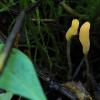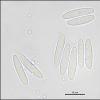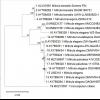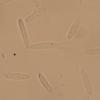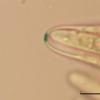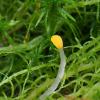
17-11-2025 21:46
Philippe PELLICIERBonjour,Récolté sur bois pourrissant de feuillu

19-11-2025 13:04
 Bruno Coué
Bruno Coué
Bonjour,je sollicite votre avis pour la récote

16-11-2025 21:09
 Robin Isaksson
Robin Isaksson
Anyone recognize this acc. to pictures.? Found on

18-11-2025 13:59
Nogueira HéctorNovember 14, 2025 Brazuelo (León) SPAIN Hymenosc

17-11-2025 19:14
herman lambertApothécie discoïde 0.6 cm diam., orangeFace hym�

17-11-2025 21:57
Philippe PELLICIERBonjour,Récolté sur bois de feuillu mort dur, no

14-11-2025 16:26
 Marian Jagers
Marian Jagers
Hello everyone, On dead wood of Cytisus scoparius

15-11-2025 23:22
Mario FilippaHello,this is what I think to be Hymenoscyphus mac

15-11-2025 20:25
 Riet van Oosten
Riet van Oosten
Hello, Found by Laurens van der Linde, Nov. 2025
Spore measurements:
(13.5) 14.6 - 17.6 (18.1) × (2.8) 3.2 - 4 (4.2) µm
Q = (3.4) 3.9 - 5.3 (5.8) ; N = 20
Me = 15.9 × 3.6 µm ; Qe = 4.5
The old paper The genus Mitrula in North America (1977) doesn't seem to clearly key out this specimen. Either this is M. paludosa or M. borealis. The spore measurements would fit M. borealis slightly better, but the spores didn't appear to have a sheath (fresh spore deposit), which might favour M. paludosa.
Any opinions?

Mitrula borealis seems to be very common in SW Finland, perhaps more so than M. paludosa. Some of my observations are recorded here, but I have many more:
https://laji.fi/observation/list?target=mitrula%20borealis
A few weeks ago I collected a Mitrula with spores even broader than borealis according to the Redhead paper. I don't know is it a borealis or still a new one.

About macroscopic differences I am not sure but the working hypothesis is that borealis is more yellow and perhaps bigger. Paludosa might have more brownish tints in the hymenium and pehaps not so elongated hymenial head as borealis.
Likewise, about ecology I have only a working hypothesis: borealis might be more common in spring fed small streams or pools while paludosa is found in any pool or ditch. All acid, virtually no calacreous sites where I collect.
The sequenced one is this:


interesting topic! I must admit I have automatically identified all my Czech collections as M. paludosa. In Czech literature, I haven´t found a mention about M. borealis, but I can see that Redhead mentions occurrence in the neighbouring Germany.
I wonder how often is M. borealis collected in this region...
Yesterday I found Mitrula in the Jeseníky Mts., so I made the first microscopy of it in my life, and it fits better M. paludosa, especially if Redhead worked with dead material. In any case, the are thinner than those in the collections from Finland presented here. Living ascospores measure (13)14.1-18.2(19.2) × (2.8)3-3.6 (3.8) µm, Q = (3.8)4.2-5.6(6.2), n = 40. Me = 15.8 × 3.3 µm; Qe = 4.8. Gelatinous sheath not observed.
Best regards, Zuzana


Spores:
(17.3) 18.1 - 21.3 (22.9) × (2.8) 3 - 3.5 (3.8) µm
Q = (4.6) 5.4 - 6.7 (6.8) ; N = 20
Me = 19.6 × 3.3 µm ; Qe = 6


